Intel Integrated Graphics Driver Crashes
Here’s a mystery for Windows-lovers (or haters) – unexplained crashes in the Intel integrated graphics driver whenever the computer is left unattended. A few weeks ago I upgraded to a new PC, choosing an HP Elitebook x360 laptop that’s mainly used in a desk-bound docked mode. This computer is running Windows 10 Pro with whatever drivers HP saw fit to preinstall. The mystery began shortly after the new computer was put into service. When I’d sit down at the computer in the morning, I’d find a log-on screen and a blank desktop. All the programs and documents that I’d left open from my previous session were gone. Why?
Hunting the Cause
My first thought was to suspect Windows Update. Probably it was downloading and installing updates overnight, rebooting the computer afterwards. That would be annoying, but at least it would be explained, and wouldn’t happen too often. But the problem reappeared every day or two over the next week, sometimes even happening twice in the same day. I never witnessed the update reboot happening (or whatever it was), but when I’d leave the computer unattended for a couple of hours or overnight, I’d often find an empty desktop when I returned.
Eventually I thought to check the Windows event viewer (Control Panels -> System and Security -> Administrative Tools -> View Event Logs). Here I found symptoms of a very different problem than I’d imagined. The computer was frequently crashing and rebooting whenever I was away:
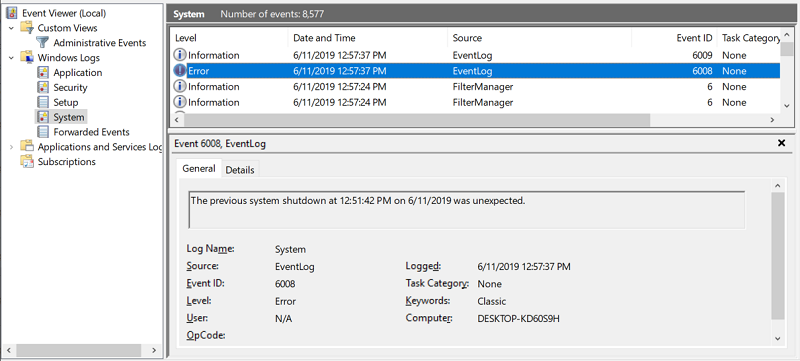
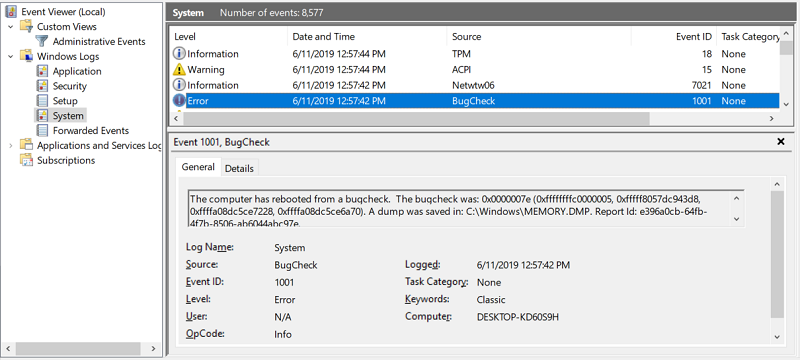
The same sequence of errors appeared five times over the last week, at seemingly random times of day: 9:25 AM, 5:25 PM, 1:26 AM, 8:21 AM, 12:57 PM. This doesn’t obviously fit with my usage of the computer. Some of the crashes happened an hour or two after I last used the computer, other crashes were 12+ hours after. The times also don’t seem to fit with any background task that I can identify.
I installed the program BlueScreenView to examine the crash dump files referenced in the BugCheck entries of the event log. Each crash dump appears to overwrite the previous one, so I was only able to example the most recent crash. To further complicate things, Windows appears to periodically delete the crash dump files according to some schedule I haven’t determined. But I was able to catch and examine several crash dumps over a few days, and all of them showed the same culprit. It was an error 0x0000007e (SYSTEM_THREAD_EXCEPTION_NOT_HANDLED) in igdkmd64.sys. A quick Google search revealed that igdkmd64.sys is the Intel integrated graphics driver for recent CPUs with built-in graphics hardware.
No Driver Update for You
My first thought was to update the graphics driver. Maybe the crash was caused by some bug that’s fixed in the current version. I visited the Device Manager and tried to update the driver there, but was told my driver version 25.20.100.6472 from December 2018 was already up to date.
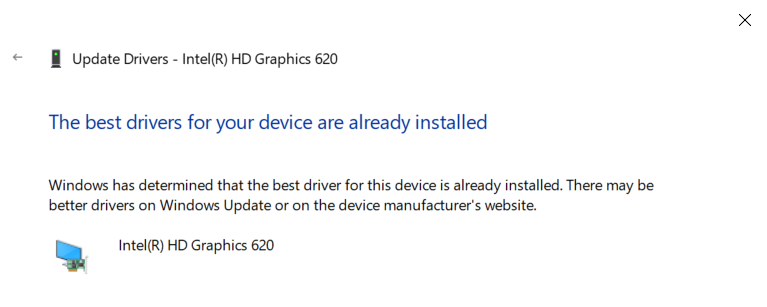
Skeptical, I visited HP’s support site and confirmed that the latest driver version there is the same 25.20.100.6472. Then I visited Intel’s site to search for the driver, and discovered that the current version is 26.20.100.6890 and was released just two weeks ago on May 29. Aha! I downloaded the driver and attempted to install it, only to be denied:
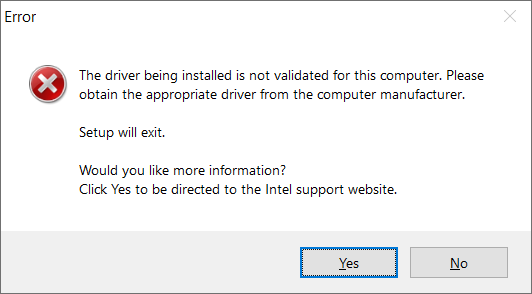
It seems I had a special HP-customized version of the Intel graphics driver already installed, and the generic driver installer refused to replace it. Some more web searching suggested that it was almost always safe to ignore this and install the generic driver anyway, using the Device Manager to directly select the driver’s INF file rather than using the driver installer. But I was denied there too. Intel recently switched to some new type of driver installation that’s not backwards compatible with previous drivers, and they explicitly warn that bypassing the installer by manually choosing the INF will result in “minor to catastrophic” issues on your computer. Here’s the full text:
Important Note:
These new drivers labeled as Windows DCH graphics drivers are not backward compatible with our previous graphics drivers that we’re now labeling Legacy. This means if later you want to revert to a Legacy driver you will need to uninstall the driver via Windows Apps and Features and reboot the system before installing a Legacy driver. Failure to do so may result in minor to catastrophic issues on your system as well as system instability.
DO NOT use the INF / Have-Disk method to install or uninstall this driver as it bypasses the Intel installer designed to install these new drivers, thereby possibly resulting in minor to major system instability. For this reason, we’re not providing the ZIP file for the next several driver releases while users transition to this new Microsoft driver platform.
There’s probably a way to circumvent this and install the driver anyway, but since I have no specific reason to believe it will fix my problem, and Intel has warned me not to do it, I’m going to leave it as is.
Idle Speculation
That leaves me with unexplained system crashes without any obvious solution. But given the type and timing of the crashes, I can speculate about the possible cause.
The crashes always occurs when the computer is unattended, never (so far) while I’ve been using it. That suggests a problem related to sleep/wake, or else with some background process that only runs when the computer is idle. But the computer isn’t sleeping, or at least it shouldn’t be. The sleep timeout is set to 18 hours, and that seems to be working correctly. I don’t think the computer is sleeping or waking when these crashes occur.
The rather strange number of 18 hours was chosen to accommodate my backup software, Paragon Hard Disk Manager 16. It’s configured to do an incremental backup to an external USB drive every night at 12:30 AM. It’s also configured to wake the computer from sleep, if necessary, to do the backup. But I found that wake from sleep didn’t work, and if the computer was asleep at 12:30 AM, the backup wouldn’t happen. By extending the sleep timeout to 18 hours, it ensures that I’ll get a backup at 12:30 AM if I used the computer any time after 6:30 AM the previous day. That’s about right for my usage. These mystery crashes started at roughly the same time as when I installed the Paragon backup software, so maybe that’s a clue, or maybe it’s just coincidence.
The second detail of these crashes is that they’re in the graphics driver, so presumably they’re somehow graphics-related. This is a laptop computer used as a desktop, so the laptop normally has its lid closed and its built-in screen disabled, while I work with an external monitor, keyboard, and mouse. This isn’t exactly a rare setup, but it’s not the most common configuration either, and maybe it’s somehow contributing to the problem. I could try leaving the computer with the lid open for a while to see if that helps, but it’s not really how I wish to use the hardware.
There’s one more clue to consider. Also in the event log, I found many entries related to a problem with gfxdownloadwrapper.exe. I couldn’t find much information about this program on the web, but it appears related to Intel graphics drivers somehow. These errors first appeared on May 29 and the last one was on June 8, but the mysterious igdkmd64.sys crash has happened three more times since then.
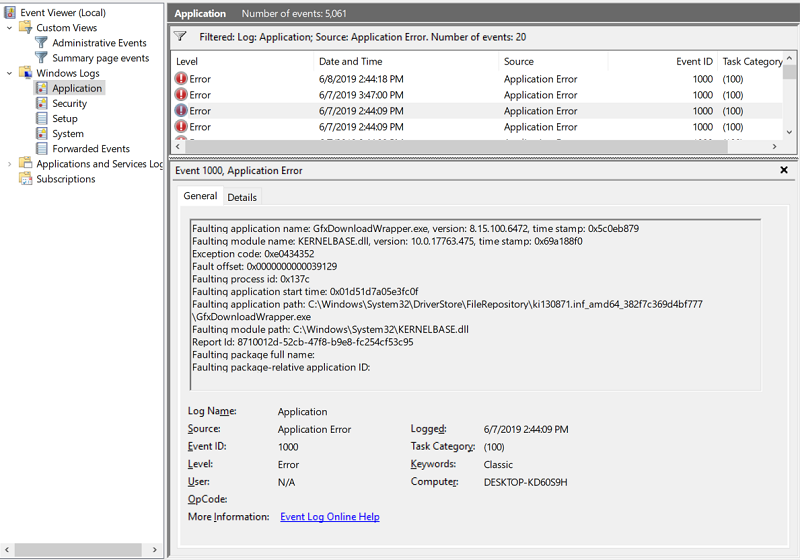
The gfxdownloadwrapper problem is related, perhaps, but not a direct cause. For now this will remain a mystery, and an advertisement for why people dislike Windows.
Read 14 comments and join the conversation14 Comments so far
Leave a reply. For customer support issues, please use the Customer Support link instead of writing comments.


You can force the install of the generic Intel driver by uninstalling the old HP-cusotmized Intel driver from Device Manager. I did this successfully on my Dell Latitude, which ships with a Dell-customized driver.
Also check your other power related settings like hibernation. Your computer may be trying to go to sleep / suspend / hibernate / etc and not making it (yes I understand you extended sleep, but there are other steps as well you might want to check). All that I can think of right now.
Hibernation / sleep was a problem on my Acer Netbook that used Intel graphics. If I put the computer to sleep while it was animating solitare or freecell, it\’d have a decent chance of blue screening instead of sleeping.
With my Lenovo with Nvidia graphics, I\’ve never seen that problem.
Hibernation is a good thought. It’s turned off: hibernate.png
The problem happened again late this afternoon, only this time there was no bugcheck entry in the event log, and no crash dump. Just an event entry saying the previous shutdown was unexpected, and another entry saying the system had rebooted without cleanly shutting down first.
Your best bet when you get a new laptop is to wipe it clean with a fresh (non hp) copy of windows 10, that will often solve problems like this. And yes, you can use the generic driver, you just have to manually install it.
The Elitebook is a business-grade machine, for which HP should have decent tech support. I would put in a call and see what happens. Could be a known issue they have a fix for…could also be a hardware problem, especially if it is rebooting with no software cause.
Sure, Windows has its issues, but it’s *way* more stable than it used to be (Windows 95/98 anyone?). It’s also an open environment that lets you do most anything you want, unlike Apple. Of course that also opens the doors for more problems due to the huge diversity of hardware and software that is available. Pick your poison. Personally, I’ll take Windows! And yes, Linux probably is good too, but just not enough software support for mainstream use, though I’m sure someone here will argue with me about it!
Update on this: I uninstalled the Intel integrated graphics driver 25.20.100.6472 yesterday, and afterwards the system ran fine for 18 hours. After uninstalling, an older driver 22.20.16.4771 was used intstead – I’m not sure where that came from, and it just instantly appeared after I unistalled 25.20.100.6472. Then after 18 hours, Windows Update downloaded and reinstalled 25.20.100.6472 again. 27 minutes later, the system crashed with the same unhandled exception error in the Intel driver. Grrr. I’ll try uninstalling again and then immediately installing 26.20.100.6890.
Discovered that the process of uninstalling and installing a new driver must be done while disconnected from the internet. Otherwise Windows immediately installs a new driver different from the one I wanted, preventing me from installing 26.20.100.6890. Once I understood that, I was able to install 26.20.100.6890 without trouble. We’ll see if it resolves the original problem of crashes when the computer is left unattended.
I have similar issue with the x360 1030 G3. Reboots or shuts itself down overnight but no logs attribute it to the graphics driver. I’ve tried updating the BIOS, firmware, newer drivers but it still happens. Interested if you find a fix for it!
This problem is getting stranger and stranger. Upgrading the graphics driver to 26.20.100.6890 has changed the problem, but not fixed it. This morning the computer was stuck on a black screen, with the fan blasting away 100%. Nothing I could do would get the desktop to appear on the external or internal screens. But I could tell Windows was still running, because I heard the sound effects for device removal when I unplugged some USB hardware, and for Sticky Keys when I tapped Shift five times quickly.
What’s worse, I also couldn’t power off the machine. I held the power button for a long time, for 30 seconds or more, but it wouldn’t shut off. Only after I disconnected everything from the computer, including AC power and the external monitor, was I finally able to force the machine off. After rebooting, the event logs didn’t show anything abnormal except some EC embedded controller warnings.
I’m going to disable the 3rd-party fan controller software I was using, and see if that helps. It does access the EC. But the clues don’t seem to fit: I was using the fan controller software successfully since May 22 and these crashes didn’t begin until June 3.
Ben what do you see in your event logs?
There have been no more graphics driver crashes since upgrading to 26.20.100.6890, but plenty of other problems. When returning to the computer after several hours idle, twice I’ve had the Start Menu quit working. Clicking on the Start icon does nothing. I’m using the vanilla Windows 10 Start Menu without any 3rd-party add-ons. Some Google searches suggest this may be related to graphics drivers on certain laptops.
I’m interested to get to the bottom of this due to pure stubbornness, but my practical side says I’m approaching the point where I should dump this computer and get a new one. Using a laptop as a desktop replacement seems to entail all kinds of headaches I hadn’t expected. My time is valuable, and I need this computer to work. I can’t afford to spend an hour or two every day screwing around with drivers and event logs and reinstalls.
Steve, I don’t have anything useful in the logs. The last entry on a Friday for example say it’s going into Standby as I leave the office (shutting the laptop lid). On Monday morning (if it shutdown itself sometime over the weekend), I get the usual boot up sequence in the logs, including “The last shutdown’s success status was false. The last boot’s success status was true.” and “The previous system shutdown at 4:59:55 PM on 14/06/2019 was unexpected.”. No indication when it actually shut down.
Odd and unexplainable lockups -> tried running a memtest?
IIRC integrated graphics still a chunk of system ram. Changing to suspend may be reliably creating a large amount of writes to a certain region (eg to shadow/dump the contents of iGPU cache, which might not stay powered in S3 and lower).
I\’ve had systems do all sorts of strange things due to memory problems. A few weeks back a machine started crashing under load, it turns out the DIMM contacts were (invisibly) corroded and re-seating things a few times fixed the problem.
Be glad you don’t have a Lenovo Yoga 2 Pro. Shipped with Windows 8.1 and iffy drivers. Lenovo did some nonsense on the board that makes every other driver you try crash more often than the one it shipped with (which still tends to crash if you look at it sideways). Fast forward to Windows 10 and you have a constant battle to keep the least crappy version of the driver installed. Even then, if you open two applications that want 3D acceleration, there is a >50% chance of the driver getting stuck in a loop of crashing repeatedly and requiring you to do a hard shutdown. Oh you want to do some 3D printing and have OpenSCAD & Slic3r both open? Crash city. Accidentally open multiple tabs in chrome that want to play video? You better have taken your anti-seizure meds. Here comes the epilepsy triggering flashes as Windows tries to kill the video driver, restart the video driver, unfreeze the applications, only to start the loop over again.